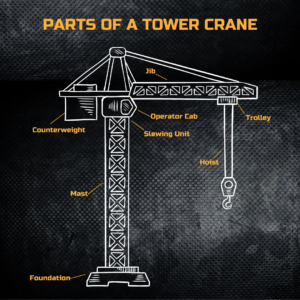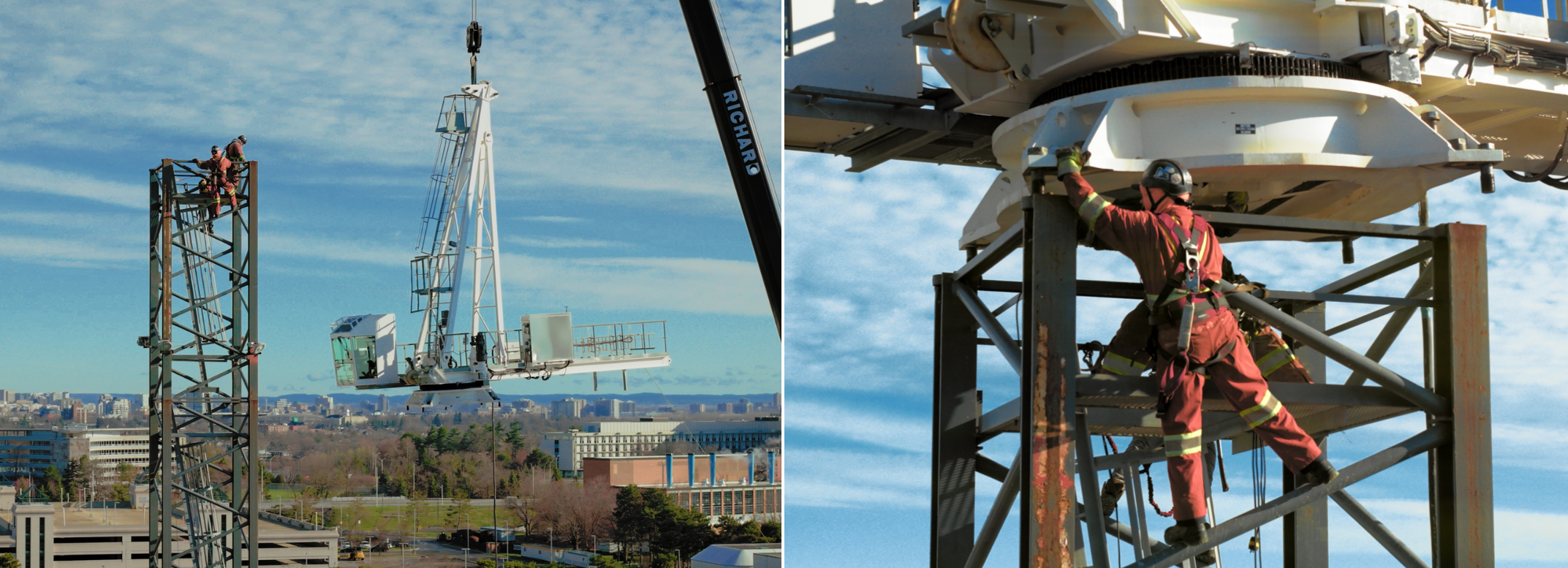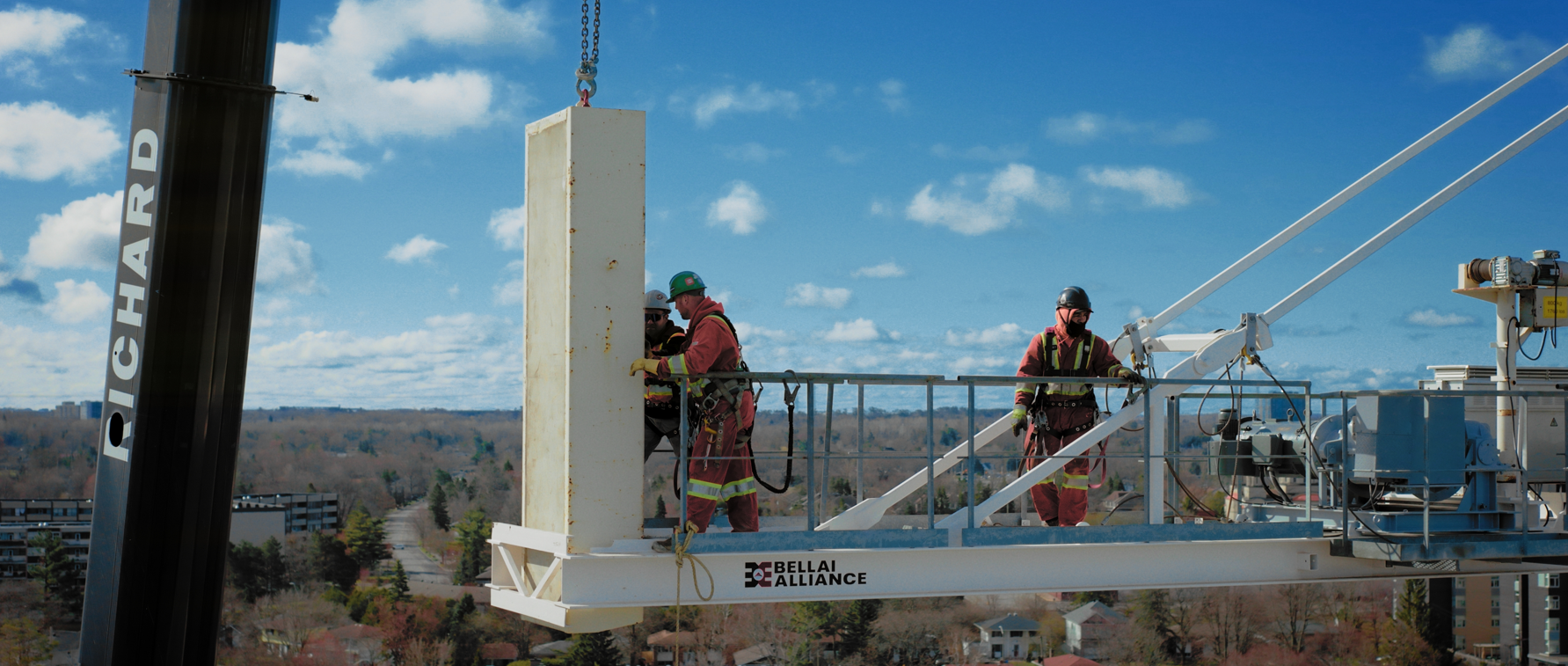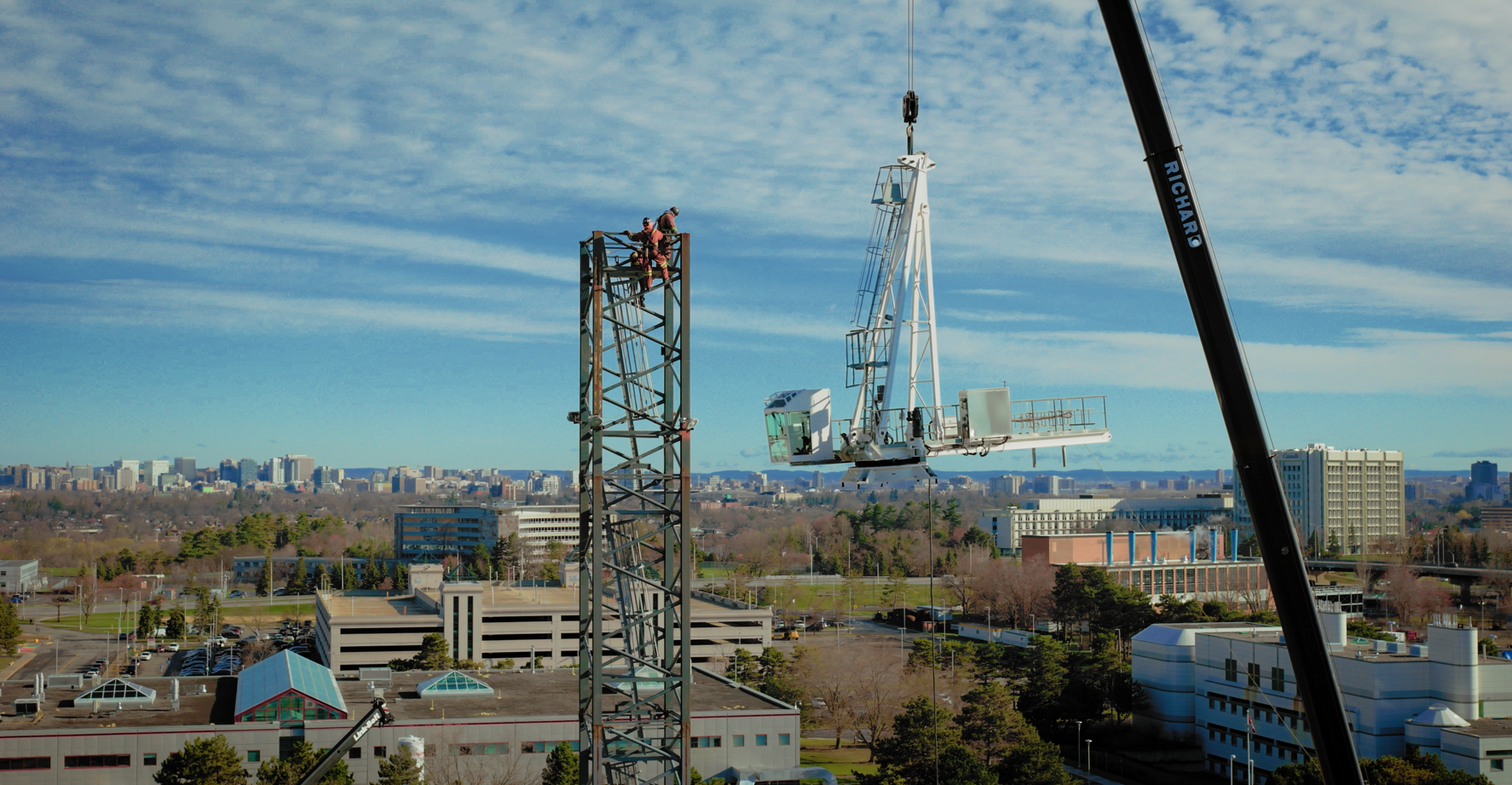Tower cranes are the backbone of any major construction project, standing tall as symbols of development and progress. Erecting these steel giants is a complex and awe-inspiring process that combines engineering excellence with precise coordination. But how are tower cranes erected? What do they use to hoist the pieces up that high?
A tower crane is typically erected using a mobile crane to lift and assemble its core components into place, including mast sections, the slewing unit, jib, and counterweights. Where mobile cranes do not provide enough height, tower cranes integrate hydraulic jacks within the structure to incrementally raise itself, also known as “climbing”.
Read on to learn more general information about tower cranes, or skip ahead to these sections to find out how tower cranes are built and assembled on site:
- Preparatory Steps Before Crane Erection
- Erecting the Tower Crane Base
- Assembling and Installing the Mast Sections
- Installing the Slewing Unit
- Adding the Jib, Counter-jib, and Counterweights
The History of the Tower Crane
The concept for the crane was born in 515 BCE in Ancient Greece. The brilliant minds of the time decided that ramps weren’t enough and they needed a better vertical lifting mechanism for heavy objects for all of their temples and elaborate structures.
Over the next 2400 years, tweaks and improvements were made, but it wasn’t until the 20th century that cranes took the next leap forward. The modern tower crane as we know it today was developed in the 1940s by the Danish company F. Linden to meet the post-World War II demand for rapid construction and rebuilding of cities and infrastructure after the extensive damage wreaked across Europe.
The tower crane was conceived as a stationary device, capable of reaching greater heights than mobile cranes and with a rotating top (or slewing unit) that allowed the crane to rotate 360 degrees, covering a wide working radius. The later addition of a telescopic mast and adjustable jib length allowed for even greater flexibility and adaptability to different construction site requirements.
The Parts of a Tower Crane: A Glossary of Terms
Below are the key components that make up a tower crane, along with a brief breakdown of each part’s role in construction and operation.
Concrete Foundation: The base of the tower crane that provides stability and support for the entire structure.
Mast: Vertical tower sections that are stacked to achieve the desired height of the crane.
Slewing Unit: A rotating mechanism mounted on top of the mast, allowing the crane to rotate horizontally.
Jib: The horizontal boom or arm of the crane that extends from the slewing unit, used for lifting and maneuvering loads.
Counterweights: Heavy weights positioned on the opposite side of the jib from the load, balancing the crane and preventing tipping.
Operator’s Cab: The enclosed compartment where the crane operator controls the crane’s movements and operations.
Hoist: The lifting mechanism, typically consisting of a drum, wire rope, and hook, used to raise and lower loads.
Trolley: A movable carriage along the jib that supports the hoist and allows it to travel horizontally for precise positioning of loads.
Climbing System: Components such as hydraulic jacks or self-climbing mechanisms that enable the crane to raise itself during erection and dismantle.
Control System: Electronic and hydraulic systems that manage the crane’s operations, including movement, load handling, and safety features.

The 3 Types of Tower Cranes
Tower cranes are categorized based on their design, lift and reach capabilities, and functionality, with the main types including hammerhead, luffing, and self-erecting cranes. Each type offers distinct advantages for various construction applications, making it essential to understand their differences to choose the right crane for the project.
- Hammerhead Tower Cranes: Hammerhead tower cranes feature a horizontal jib with a counter-jib, forming a “hammerhead” shape, providing excellent lifting capabilities and maneuverability, making them suitable for various construction projects, especially in dense urban areas.
- Luffing Jib Tower Cranes: Luffing jib tower cranes are equipped with a jib that can be angled or “luffed” upwards or downwards, allowing for precise load placement in confined spaces or in areas with overhead obstructions, making them ideal for high-rise construction projects.
- Self-Erecting Tower Cranes: Self-erecting tower cranes are designed to be easily transported and assembled on-site without the need for additional equipment, featuring a hydraulic system that allows them to raise and lower their sections autonomously, offering flexibility and efficiency for smaller construction projects or sites with limited space.
The Role of Tower Cranes in Construction
Tower cranes are vital in constructing high-rise buildings, bridges, and other large structures. They facilitate the lifting of heavy materials like steel, concrete, large tools, and other construction materials to great heights, playing a crucial role in the timely and efficient completion of construction projects.
Their main roles on modern construction sites include:
- Lifting heavy materials to great heights with precision
- Facilitating efficient and timely construction processes
- Supporting various construction tasks such as concrete pouring, steel erection, and equipment assembly
- Providing a stable and secure platform for workers to perform tasks at elevated heights
- Assisting in the removal and demolition of structures, clearing the construction site and preparing it for the next phase of development
How Tower Cranes Are Erected
Tower cranes are a common sight at construction sites where tall buildings, bridges, or large structures are being erected. They are the workhorses of the construction industry, capable of lifting heavy loads to great heights. But before they can perform their tasks, they must first be assembled piece by piece, a process as intricate as the operations they are designed to perform.
1. Preparatory Steps Before Crane Erection
Before a tower crane can rise, careful planning is necessary, starting with location scouting. Site engineers and crane specialists conduct soil tests to ensure the ground can support the crane’s weight.
2. Erecting the Tower Crane Base
Based on these tests, a concrete foundation is laid, often reinforced with steel to provide a stable base. The dimensions and depth of this foundation are critical and depend on the crane’s size and the loads it will carry.
3. Assembling and Installing the Mast Sections
Initially, a mobile crane is used to assemble the tower crane mast sections. This auxiliary crane must have a higher lift capacity than the tower crane’s heaviest component. The mast, the vertical tower-like structure, is assembled section by section. Using a mobile crane,, each mast section is carefully lifted from the ground or staging area.

Rigging straps or chains are used to attach the crane’s hook to the section, maintaining balance and control during the lift.
Once a section is hoisted above the previously installed section, workers guide it into place. The sections of the mast have male and female ends or flanges with holes for bolts, ensuring a precise and secure connection. The alignment must be exact to facilitate a smooth connection and to maintain the structural integrity of the mast.
After aligning the sections, workers secure them together with bolts. The bolts are inserted through the aligned holes in the flanges of the connecting sections. They are then tightened, often in a specific sequence and to a specified torque, to ensure an even and secure fit that distributes the load evenly across the joint.
This process is repeated for each subsequent section of the mast until the desired height is reached. Workers often work from within the mast, moving up as the structure rises, to secure each section from inside, ensuring a stable and safe assembly process.
4. Installing the Slewing Unit
Atop the mast sits the slewing unit, which allows the crane to rotate 360 degrees. This unit contains the crane’s motor and gear, enabling the horizontal movement of the jib (the working arm of the crane) and the counter-jib (which balances the jib’s weight).
Using a mobile crane, the slewing unit is lifted off the ground and raised to the top of the tower crane’s mast. Ground crews and communication via radio ensure the unit is safely and accurately hoisted, with spotters guiding the alignment as it approaches the mast’s summit. The slewing unit, designed to fit precisely onto the mast, is carefully lowered into position.

Once aligned, it is bolted to the mast, ensuring a secure attachment that can withstand the operational stresses of crane movement. The final steps involve connecting the unit to the crane’s electrical and hydraulic systems, followed by a series of tests to confirm that the slewing mechanism functions correctly and safely.
5. Adding the Jib, Counter-jib, and Counterweights
The jib, a long horizontal beam, is attached to the slewing unit. It’s where the load is lifted using a trolley and hoist line. Opposite the jib, the counter-jib is fitted with counterweights, typically made of concrete, which balance the crane’s load.

6. Climbing Tower Cranes
For cranes that need to reach greater heights, a climbing section is inserted into the mast, allowing the crane to “climb” as the building rises. This process involves a climbing frame or jacking cage to temporarily support the slewing unit and the upper parts of the crane, allowing room for a new mast section to be inserted below.
The climbing frame hydraulically lifts the upper parts of the crane, creating space for the new section to be added at the base of the erect portion of the mast. This method allows the crane to grow in height alongside the building it’s constructing.
7. Final Checks and Commissioning
Once assembled, the crane undergoes thorough testing to ensure all mechanical, electrical, and hydraulic systems function correctly. Load tests are performed to verify the crane’s capacity and safety mechanisms.
How Long Does it Take to Erect a Tower Crane?
It can take anywhere from a few days to several weeks to erect a tower crane, and it depends on several factors including size, complexity, location, and weather.
Safety Measures During Crane Erection
Safety is paramount in crane erection. Technicians and engineers must adhere to strict safety standards and regulations throughout the assembly process. This includes using personal protective equipment (PPE), completing required training and certifications, and routinely inspecting equipment.
Proper planning, skilled personnel, and adherence to safety protocols are essential for efficient and timely tower crane erection.
Use of Personal Protective Equipment (PPE): Workers should wear appropriate PPE, including hard hats, high-visibility clothing, safety harnesses, and steel-toed boots, to protect against potential hazards such as falling objects or slips, trips, and falls.
Training and Certification: All personnel involved in crane erection must be properly trained and certified to perform their tasks safely, covering proper assembly techniques, equipment operation, and emergency procedures. Certifications should be maintained, monitored, and easily accessible for verification.
Equipment Inspections: All crane components, including mast sections, bolts, pins, and hoisting mechanisms, should be inspected for damage or defects before assembly. Any faulty equipment should be repaired or replaced before proceeding with erection. Making inspection forms easy to access and easy to verify is very important on a busy job site.
Pre-Erection Planning: Before starting the erection process, thorough planning is essential. This includes conducting site assessments, identifying potential hazards, and developing comprehensive erection procedures. Clear communication between the erection crew, crane operator, and other workers is vital to ensure everyone understands their roles and responsibilities.
Emergency Response Preparedness: In case of emergencies or accidents during crane erection, workers should be trained to respond quickly and effectively. Emergency policies and procedures, including evacuation routes and first aid protocols, should be easily accessible and practiced regularly.
By implementing these safety measures, construction teams can minimize risks and ensure a safe and efficient crane erection process. Prioritizing safety not only protects workers but also contributes to the successful completion of the construction project.
What to Choose: Mobile Crane vs. Tower Crane
Understanding the differences between mobile cranes and tower cranes is essential for selecting the right equipment for construction projects. Below is a detailed table outlining the key reasons for choosing mobile cranes vs tower cranes, which should be considered when deciding on the best option for the project.
| Mobile Crane | Tower Crane</> | |
|---|---|---|
| Height and reach | Limited reach and height. | Tower cranes offer superior height and reach capabilities, making them ideal for constructing tall buildings and structures. |
| Site Requirements | They require a large, stable, and level area for operation, which can be a drawback on congested or uneven sites. | Tower cranes have a smaller footprint and are rendered stable by the concrete foundation laid for their base. |
| Flexibility/Mobility | As the name suggests, a mobile crane is mobile — move it around site, or between sites as needed. | Once you plant them, they stay planted, in a bed on concrete. |
| Set-up/Assembly | Mobile cranes can be set up and become operational in a much shorter time frame compared to tower cranes. | The process of erecting and dismantling a tower crane is time-consuming and requires significant planning and resources. |
| Weather Conditions | The shorter the crane, the lower the wind speed it’s exposed to. Especially with features like a telescopic boom, which allows the crane to retract the boom and further lower the center of gravity. | >Because of their height, tower cranes are more susceptible to adverse weather conditions, such a high winds, which can halt operations |
